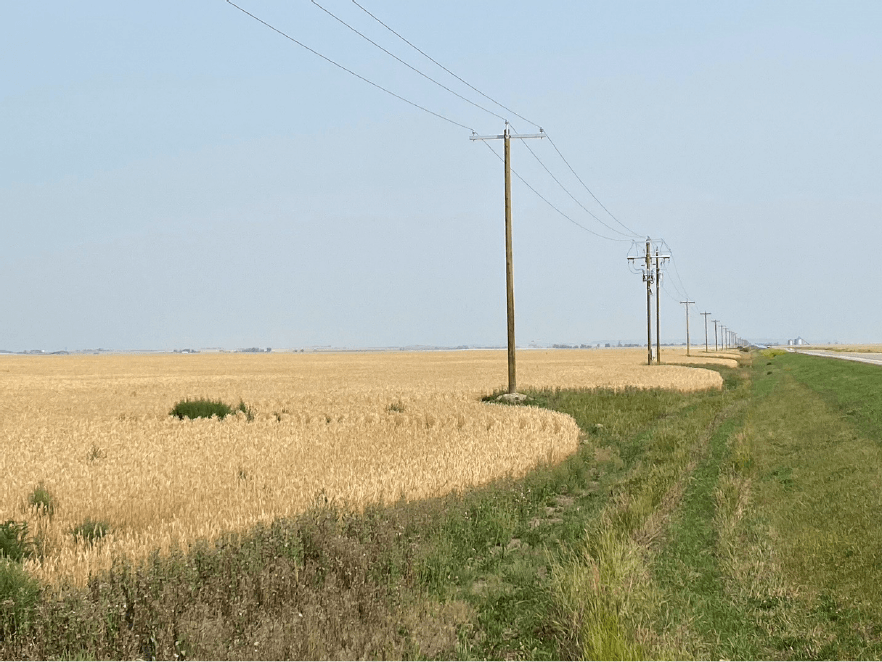Good Fences Make for Good Habitat
By Craig Lester
Standing on the edge of a highway in southern Alberta, Pheasants Forever Canada Executive Director Perry McCormick looks northward. A golden yellow crop waves in the wind, stretching almost as far as the eye can see. A sample of the landscape that makes southern Alberta so picturesque.
So, what’s wrong with this picture?

Where a fence would normally stand separating private land from the public, the crop weaves into the right-of-way, darting in and out of the power poles, gobbling up natural habitat and creating a potential safety hazard for seeding and harvesting equipment working between the utilities.
It’s a twist on the old saying ‘good fences make for good neighbours,’ which, in this case, means good habitat.
During a Save the Edges media tour in mid-August, McCormick showed many instances where the seeder had come right up to the roadside, in its wake, wiping out the natural grass, and it also forced the birds and insects to find another home if they can find it.
Bevy of Benefits – View the Infographic
The rise of trespass farming over the past couple of decades has been slow and gradual, and for the most part, it has largely gone unnoticed, says McCormick. As farmers are pressed to get more out of the land to feed a growing population, McCormick says he understands the plight producers are facing. However, he says the benefits of leaving the habitat intact and protecting the public right-of-way can pay dividends to the crops farmers are growing.
“Every square inch of soil out there is under some threat from a habitat standpoint. We feel that’s public land, and it should be protected for all of society to benefit from.” He says the benefits of that lush vegetation on the side of the field play a vital filtration role. “Producers today have to put a lot of product on the landscape to get the crops they do today. The by-product, or those chemicals, have to go somewhere, and that vegetation in those ditches holds those nutrients up on the landscapes and puts them to work.” He says fertilizer will stay in the ditches, in turn helping the vegetation there grow all kinds of things like pollinators and insects and biodiversity, from bugs to beetles to birds and mammals. “These healthy ditches and edges provide a variety of insects, many of which prey on other insects that feed on the crops. They can actually reduce some of their inputs by keeping these edges intact.”
Saving the Edges also aligns with the hot topic of climate change, as it promotes carbon sequestration. “These vegetative strips provide a good opportunity for the sequestration of carbon.” These strips of vegetation are also home to pollinators, which bring a wealth of positive outcomes for fields. Bee boxes dot the southern Alberta landscapes with many set-ups in right-of-ways and ditches in the same place where the good habitat is formed. “They’re strategically moved around counties to help pollinate our crops. Again, those places should be left as they are and let them do the good work they’re doing for all of us.”
Loss of Native Grass
The Pheasants Forever Save the Edges campaign comes as the organization is also raising alarms about the loss of native grass and biodiversity in southern Alberta. McCormick says they are concerned about the next few years. “There are several green infrastructure projects that are on the books and, unfortunately, windmills solar panels are just not a positive thing from a biodiversity standpoint, and we risk losing more native grass.” McCormick says this just underlines the importance of protecting the ditches and right-of-ways, preserving the habitat necessary for keeping our biodiversity where it’s at.
Play a Key Role
Despite the growth of trespass farming over the past few decades, McCormick believes things are headed in the right direction. He says farmers are starting to understand the benefits of edges on their properties. “That might not have been the case in the past few decades, but as we learn and grow, we start to understand the benefits that these things bring.” As the old saying goes, ‘good fences make for good neighbours,’ in this case being the habitat that exists in the ditches and public right of ways.
Save the Edges is bringing awareness of the issues of trespass farming and the values of intact roadside ditches and undeveloped public right-of-ways to southern Alberta’s landowners.


